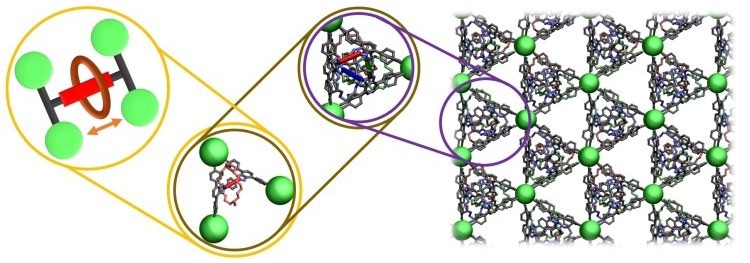Many of the basic natural processes are managed by molecular machines. These processes, which are integrated into the cellular environment, are crucial for both the intracellular and intercellular transport of molecules as well as the contraction of muscles in both humans and animals.
 Embedding of the “molecular shuttle” in the metal-organic framework: schematic representation of the molecular shuttle (yellow circle), together with its molecular structure (brown circle) and its embedding in the periodic structure (violet circle). Image Credit: © Kolodzeiski/Amirjalayer.
Embedding of the “molecular shuttle” in the metal-organic framework: schematic representation of the molecular shuttle (yellow circle), together with its molecular structure (brown circle) and its embedding in the periodic structure (violet circle). Image Credit: © Kolodzeiski/Amirjalayer.
A clearly defined orientation and arrangement of the molecular machines are necessary for the proper operation of the entire organism. For instance, a dynamic interaction between countless proteins is made possible by the precise embedding of motor proteins, which constitute a class of biomolecular machines. Movement at the molecular level is therefore amplified and transmitted at different magnitudes all the way up to the macroscopic level.
The creation of cell-like materials based on synthetic molecular machines is a prevailing area of research that is motivated by these biological systems. A thorough understanding of both the molecular embedding in a matrix and the intermolecular interactions is crucial to use the molecular cooperativity of these machines in corresponding materials specifically for applications in materials science or medicine.
Elena Kolodzeiski and Dr. Saeed Amirjalayer from the University of Münster’s Institute of Physics are the first to use molecular-dynamic simulations to successfully show the dynamic interaction of a class of synthetic molecular machines known as molecular shuttles. The research was published in the journal Science Advances.
Dumbbell- and ring-shaped molecules that are connected to one another by mechanical bonds make up molecular shuttles.
This mechanical link at the molecular level leads to the ring being able to move directed from one side to the other along the axis. This specific pendulum movement has already been used to develop molecular machines.
Dr. Saeed Amirjalayer, Institute of Physics, University of Münster
Amirjalayer headed the research and recently moved to the Institute of Solid-State Theory at Münster University.
Based on this, scientists from all over the world are attempting to use these molecular machines specifically in functional materials. These mechanically linked molecules can be embedded in cell-like structures using metal-organic frameworks, which are constructed in a modular manner by organic and inorganic building units.
Despite the synthesis of a number of these systems over the past few years, a fundamental understanding of the dynamic processes occurring in these materials has largely been lacking.
Our study provides a detailed insight into how embedded machines function and interact. At the same time, we were able to derive parameters which make it possible to vary the type of movement of the molecular shuttles within the metal-organic frameworks.
Elena Kolodzeiski, Study Lead Author, Institute of Physics, University of Münster
Targeted control of the dynamics holds a great deal of promise for influencing the transport characteristics for coordinating catalytic processes or of molecules in membranes.
The scientists are hoping that new kinds of materials for catalytic and medical applications will be built on the foundation of their molecular dynamic simulations. The various ways in which biological cells’ molecular machines function demonstrate just how effective such materials can be.
The study was financially supported by the German Research Foundation.
Journal Reference:
Kolodzeiski, E. & Amirjalayer, S. (2022) Dynamic network of intermolecular interactions in metal-organic frameworks functionalized by molecular machines. Science Advances. doi.org/10.1126/sciadv.abn4426.